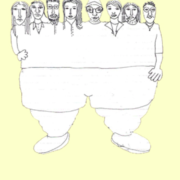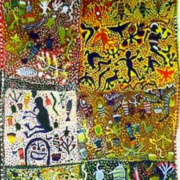Presentation: Anorexia, Adolescence, Group
In 2004, Funzione Gamma introduced the 14th edition of “Groups with anorexic patients: therapeutic factors”. Today, we are glad to present the continuation of the dialogue we started back then, to further proceed in our attempt to combine theoretical model and clinical intervention in the 24th edition of “Anorexia, Adolescence, Group”. The title already hints that the theme of identity constitutes the invisible path that will guide us through this edition. As Rouchy (1987) writes, “It is impossible to declare our identity without naming one of the multiple groups to which we belong”. As human beings, we live in groups. Our sense of identity arises and develops from these various affiliations. The group is an essential element of human existence: men are born in groups, they play in groups, they fight in groups and against groups, and all religious and heathen rites are celebrated in groups. In the field of neuroscience, research has shown how the mind develops through relationships. The development of our nervous system is an experience-dependant process: in the early stages of life, significant relationships are the main source of experience, which also modulate genic expression at a brain level. Relationships with others have a great influence on the brain. The circuits that mediate social experience, are closely related to those underlying the integration of the processes controlling meaning attribution, memory organization, modulation of emotional responses and regulation of the body functions (Siegel, 1999).
In his theoretical formulation of motivation, Lichtenberg (1989), along with several other motivational systems, suggested the system of affiliation, which is specifically focused on the need to belong to a group (a family group at first, and a social one later on). Our Self develops thanks to the experience we have in the groups we belong to and in which we grow up. Conversely, when we do not have any contacts with other groups outside our family or social network (Pontalti, 2001), or, like in other extreme cases, when a person is isolated or trapped in a family group which implicitly or explicitly does not allow the transition to other groups, dangerous psycho-pathogenous issues arise. Obviously, we are not claiming that all the groups we participate to have the same importance, nor that they all facilitate the development of the individual identity, since the characteristics and functions of different groups vary according to their size and objective. The groups which do not favour the development of the identity are those in which people feel anonymous and diminished, or in which they feel they are being used to reach aims that might endanger them. What happens to a person who develops an eating disorder? What position does or did this person have towards the groups that he or she participated to? What do they mean to him or her? Generalizing, we know that people suffering from eating disorders usually feel like they do not belong to any group, and they do not accept what comes from the outside. They simply refuse the outside reality, keeping it in a fantasized never-ending present. The treatment starts working right when the patient belongs, re-experiments or establishes for the first time a connection, tolerating the relative anxiety and threat that this may carry – threat of abandonment or of a violent intrusion. Stereotypically speaking, a person suffering from nervous anorexia is often a young Caucasian woman, well educated, who comes from the middle-class, and who at some point in life, during adolescence, retreats from reality and shuts herself in her personal world, apparently uninhabited. It is a well-established convention that eating disorders develop under the influence and the adoption of western values. Even if there is no scientific evidence to support it, we do not think that there is a direct cause-and-effect relationship between culture and eating disorders. Field specialists very well know that culture reinforces previous behaviours, attitudes or needs. The debate is still open on the complex interrelation and mutual influence of these two dimensions – also cross-generationally, like Comelli shows in his work included in this edition. Undoubtedly, among psychopathological disorders, eating disorders distinguish themselves by their degree of correlation with social and cultural phenomena. Studying these disorders without considering its cultural aspects, would be like watching a group of actors on a stage without scenography. While watching a play, we know that some essential elements do not depend from the scenography, but they are key elements for the understanding of the specific expression of the play. We suggest that the same relation can be observed between cultural context and eating disorders. Recent data shows that eating disorders develop in several parts of the world, included those that used to be regarded as sheltered from these phenomena (Pike & Borovoy, 2004). The effects of the socio-cultural factors on the evolution, course and outcome of the main mental disorders, can be regarded as pathoplastic, because they give a different structure to psychopatological contents. For instance, some symptoms can carry messages of ‘collective’ protest conveying discomfort, anger, resignation, and helplessness. From this point of view, Manzoni’s work (in this issue), further sensitizes us to the issue: “One thing I now believe is that in our society, the impression is given, by both men and women, that the attitude to ‘do’ prevails over the attitude to ‘be’, and this makes me think that anorexia represents the socially recognized symptom of big and spread uneasiness which is still ignored and neglected but which concerns us all”. Several authors have suggested a parallel between the spread of mass hysteria at the end of the 19th century and the spread of eating behaviour disorders in modern times. To focus on the transitions of women’s social and identity role, and to relate them to this kind of psychopathologies, means to try to analyze the complexity of these symptoms (Miglioli, 2009). Whereas the nineteenth-century hysterical patient through her symptoms showed the need for subjectivity in a patriarchal society, a person suffering from an eating disorders shows his or her discomfort in relation to the acquisition of identity and independence in a post-modern age of confusion of roles and functions, supported by the blurred boundaries of emotional relationships. As Comelli states in this issue, eating disorders reflect a deficiency in the process of symbolization. During adolescence, the process of symbolization of the body, namely the creation of mental images of the body, involves a great deal of work. Hence, the decline of its pre-eminence disguised as physicalness, promotes the progressive separation from the body and the development of the psyche. Through the strength of the biological changes occurring during adolescence, it is the body which presents itself to the mind. The body becomes a place for the unspeakable aspects of growth, but it is through similar experiences that the mind progressively finds its way into the body. From this perspective, the body also undertakes a symbolic role. Through their body, adolescents symbolically express their conflicts with their interaction modalities (Marcelli & Braconnier, 2004). Gabrielli and Nanni in this issue dwell upon the “adolescence-anorexia” dualistic vision, in terms of a developmental challenge typical of that life stage, connected to the acquisition of a new integration of body and mind. The authors claim that the homogeneous group space appears to be the chosen place for the transformation of possible obstacles or deviations from this process, precisely in those cases in which such hindrances take the shape of an eating disorder. While discussing the group setting, the authors particularly praise the therapeutic use of the fertility myth and its transformative value. Furthermore, they also emphasize the importance of the socio-cultural aspects while approaching these psychopathological phenomena: “Starting off from this idea, we would like to concentrate on the possible reading of the anorexic disorder as being an expression of individual suffering, and at the same time a pathology which has roots in the social psyche, giving an explanation to the surprising and worrying present spreading of anorexia. Imagining society as a wide group animated both by psychological factors linked to the myth of thinness and aesthetics, and also by remote unconscious elements, anorexia would not only shape itself as the illness of a superficial and aesthetical collectivity, but as an intrinsic manifestation of unconscious social dynamics. Such dynamics that are not yet able to be elaborated and narrated by the mind individuate in the body a skilful narrator, and a stage on which to act the primitive mechanisms of personal and collective childhood”. Eating behaviour disorders, like other behavioural disorders during adolescence, acquire the meaning of adaptive behaviours. They are a tragic self-therapeutic attempt of coping with a threat of invasion coming from a Self that feels unable to handle stress. It also feels its hunger for what is outside, but it perceives it as a threat to its identity, of losing its limits, of fading into the object of need (Bruch, 1962; 1973). Therefore, we believe that in this collection of studies we discuss several crucial points around which the debate on the treatment of eating disorders revolves. We described groupality as a vitalizing component of human beings and as a key factor in group psychotherapy. Within the therapeutic treatment of eating disorders, this finds its application in the homogenous time-limited group treatment experience. Vasta and Scopetta describe such a group experience conducted within an institutional setting, along with the treatment model on which it is based. Clinical sequences clearly show that patients benefited from the specific therapeutic opportunities that this peculiar group mechanism offers. Furthermore, this edition states the benefits deriving from the integration of cross-disciplinary figures in the treatment of eating disorders, precisely because of its complexity and multidimensionality. Concerning this, Combe’s “therapeutic group”, masterly outlines the delicate weave of mutual contributions involved in teamwork. Such group, as the author writes, includes a “psychoanalyst, an endocrinologist and a nutritionist”. The multidisciplinary therapeutic approach supported by the Ministry of Health (through the study committee for the assistance of patients suffering from anorexia and bulimia), by international guidelines and by scientific literature, defines treatment as a global project of integration of professionalism and specialized competence sharing. It is not a mere sum of specific skills, nor the overlapping of professional fields. In fact, it is widely known that treatment possibilities depend on early diagnosis and intervention, on the integration among different health care services, and on the possibility to differentiate interventions depending on the complexity of a given pathology. When a team of carers takes on an adolescent patient, we know that this means taking on the whole family. In this edition, the involvement of the parents shown by Combe’s group therapy, as well as the group support for the family members of the patient suffering from an eating disorder suggested by Bruno, are evidence for the effectiveness of a specific focus on the family dimension in these kind of disorders. Lasengue already sensed it in 1873. Loriedo also sees the pioneering value of the French doctor’s work, who was the first to understand the importance of the family environment in the etiopathogenesis of anorexia: “we should not be surprised if, differently from the way we are used to, I always sense a parallelism between the patient’s morbid condition and his or her entourage’s concern. These two elements are intertwined, and by only taking the disorder into account, we would not have a correct knowledge of the disorder” (Lasengue, in Loriedo, 2008). To conclude our introduction to this issue, we would like to indicate yet another element of value pointed out by all the authors, for which we are particularly grateful. In fact, their collective work shows a scientific and cultural environment where it is possible to share and compare different theoretical and empirical models for the treatment of eating disorders. Let us think, for instance, to the Lacanian perspective of Di Cioccio and Terminio. They both adopt this perspective to focus on social factors while discussing eating disorders – as we have seen, other authors do too, even if they start from different theoretical points of view. From the same perspective, Di Luzio suggests an etiopathological viewpoint for eating disorders, starting from the theoretical framework of the Psychology of the Self, to describe a mechanism and a group treatment process which are consistent with these assumptions. We would like to take this opportunity to express our hope for an integration between the various models for the treatment of complex and multiform pathologies like eating disorders, when such an approach proves to be clinically effective.
References
Bruch H. (1962) Perceptual and conceptual disturbances in anorexia nervosa, Canadian Journal of Psychiatry, 26:187-194.
Bruch H. (1973) Eating disorders: Obesity, anorexia nervosa, and the person within, Basic Books, New York.
Lichtenberg J.D. (1989) Psychoanalysis and Motivation, The Analytic Press, Inc., Hillsdale, New Jersey.
Loriedo C. (2008) Nuovi orientamenti nella psicoterapia-relazionale sistemica dei disturbi dell’alimentazione: dall’anoressia al binge eating disorder. In Le relazioni e la cura, Chianura P. et al. (A cura di). Franco Angeli, Milano.
Marcelli D., Braconnier A. (20046e éd.) Adolescence et Psycopathologie, Masson, Paris.
Miglioli M.S. (2009) Spunti per una lettura epidemiologica ed eziopatogenetica. Analisi dei fattori storici, sociali e culturali. In I gruppi nei disturbi alimentari, Gibin A.M. (A cura di). Franco Angeli, Milano.
Pike K., Borovoy A. (2004) The rise of eating disorders in Japan: Issues of culture and limitations of the model of “Westernization.” Culture, Medicine and Psychiatry, 28(4):493−531.
Pontalti C. (2001) L’oscillazione identità appartenenza in psicoterapia analitica di gruppo. In Identità e relazione, Visani E., Cammillocci Solfaroli D. (A cura di). Franco Angeli, Milano.
Rouchy J.C. (1987) Identité culturelle et groupes d’appartenance. Revue de Psychothérapie Psychanalytique de Groupe, 9:31-41.
Siegel D.J. (1999) La mente relazionale. Neurobiologia dell’esperienza interpersonale, Cortina, Milano, 2001.
English translation by Giulia Lampis








